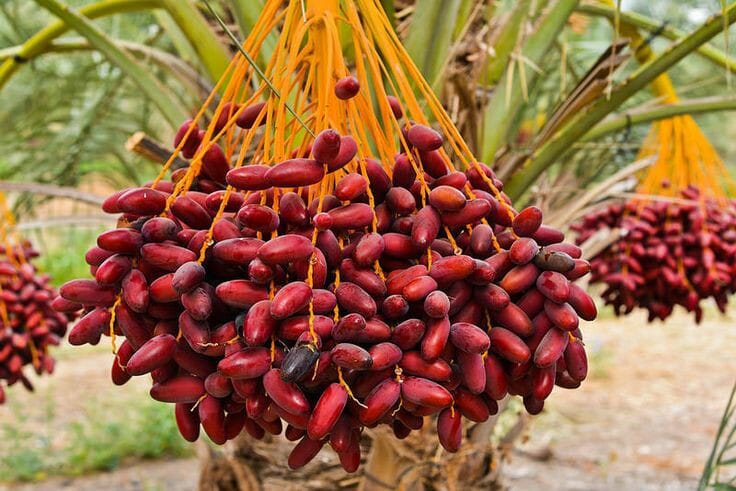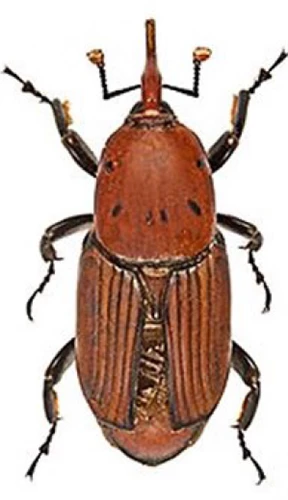
The Red Palm Weevil is one of the most significant pests of date palm plantations in countries surrounding the Mediterranean Sea and the Persian Gulf. This pest was introduced to Iran in 1989 and currently affects the provinces of Sistan and Baluchestan, Fars, South Kerman, and Hormozgan.
Damage and Signs of Infestation
The insect penetrates the trunk and offshoots of the tree, creating tunnels inside. The larvae feed on vascular bundles, the central shoot, tender and unformed fronds, and petiole tissues. This causes the tree to turn yellow, wilt, and ultimately collapse and die under severe infestation.
Signs of infestation include:
- A distinctive sour or rotting smell emanating from the trunk.
- Presence of chewed fibrous materials resembling sawdust at entry points on the trunk, accompanied by brown sap oozing out.
- Audible feeding sounds of larvae resembling rasping.
- Multiple larval tunnels visible on the trunk.
- Empty pupal cocoons at the base or on the trunk of the tree, and in severe cases, the presence of adult insects on the trunk and near holes.
- Drying of the central shoot, eventually leading to the death of the tree.
- Trunk breakage and collapse of the crown in severe or prolonged infestations.
Morphology
- Eggs: The eggs are creamy white, rice-shaped, and laid on the trunk, especially in wounds from pruning, removal of offshoots, or soft tissues at the base of leaves and damaged petioles.
- Larvae: The larvae are large, thick, legless, and creamy-yellow with reddish-brown head capsules. Fully grown larvae measure up to 50 mm in length and 20 mm in width and may undergo up to 13 instar stages.
- Pupa: Pupae are brown, encased in fibrous cocoons inside the tree trunk. The surface of the pupae is shiny and grooved.
- Adult: Adult insects are large, reddish-brown or henna-colored, measuring 30–35 mm in length and 10 mm in width. They possess long rostrums, which are curved at the tip. Antennae are 12-segmented and rest in grooves on the rostrum when not in use. The thorax may have spots, and the elytra (wing covers) are short, not extending to the end of the body, with visible grooves.
This pest exhibits sexual dimorphism:
- Females: Longer and slimmer rostrum, hairless.
- Males: Shorter, thicker rostrum with a dense tuft of reddish-brown hair at the tip.

Biology
After mating, females can lay between 300–500 eggs. The eggs hatch within approximately 3 days, and the larvae quickly penetrate soft and tender tissues of the tree, feeding for about a month. During this time, they create numerous channels in the tree. After feeding, the larvae exit the trunk and form cocoons from dry palm fibers, where they pupate. Overlapping generations are common, and all life stages of the pest can be observed year-round.
Pest Monitoring
Before implementing management strategies, pest monitoring is essential to identify infestations. This can be achieved through visual inspections of palms in suspected areas and pheromone food traps to capture adult pests. Trapping can help estimate pest population density and flight activity, guiding control measures. A minimum of 1–2 traps per area, particularly in regions with young palms and offshoots or where pests prefer certain date varieties like Mazafati, is recommended.
A GPS-based Android application called "Henna Tracker" can assist in pest monitoring and identifying infested areas.
Pest Management
- Sanitation Practices:
- Remove offshoots, prune leaves, and burn residues.
- Treat wounds with copper-based compounds or garden sealants.
- Maintain proper irrigation and spacing between trees for good orchard hygiene.
- Regular Inspections:
Conduct regular checks to detect infestations early. - Mass Trapping:
Use food-pheromone traps to capture adult weevils. - Chemical Control:
- Preventive and curative chemical treatments.
- Use fumigants such as aluminum phosphide in larval tunnels of affected trees. Seal the trunk with plastic after application.
- Removal of Severely Infested Trees:
Completely uproot and destroy heavily infested trees. - Prohibition of Plant Movement:
Restrict the transfer of plant materials, especially offshoots, from infested areas.
Powered by Froala Editor
Powered by Froala Editor